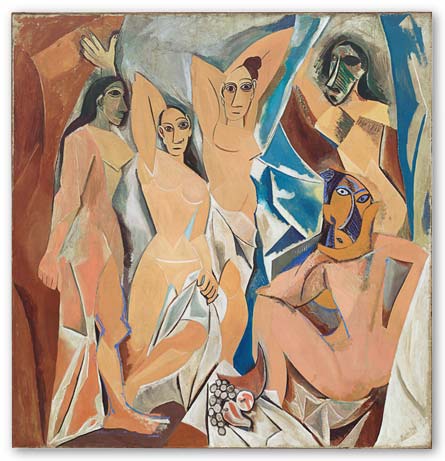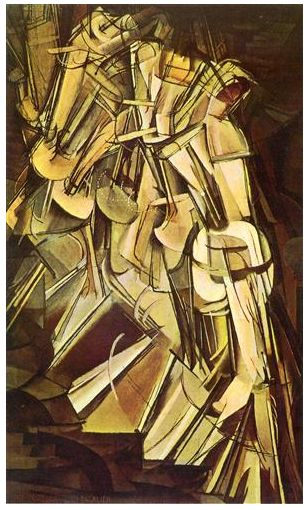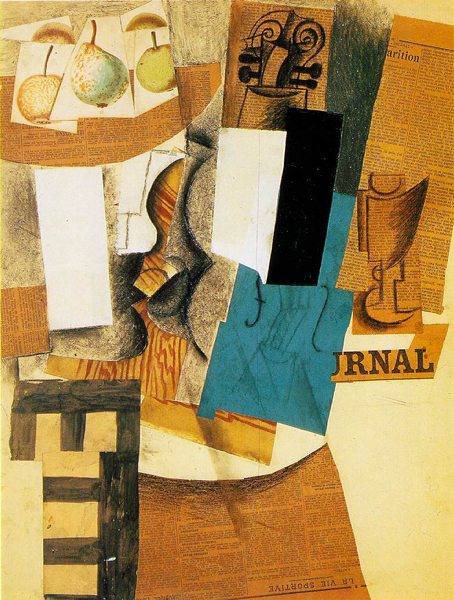
What is Cubism?
Cubism is a highly recognizable art movement which originated with Pablo Picasso (1881–1973) and Georges Braque (1882–1963) in Paris between 1907 and 1914. It is generally seen as the first abstract art movement. Cubism rejected the traditional goal of art, that of creating a facsimile of nature, and instead emphasized the two-dimensionality of the picture plane. Typical features of cubist art include multiple perspectives, hard geometric forms, exaggerated or stylized features and flat or monochromatic color. The cubists were primarily painters and focused mainly on still lives, with some representing the figure and portraits as well.
The Backstory:
In the early twentieth century, people’s vision of the world was rapidly changing. Technology such as cinematography and automobiles was effectively making the world a smaller place, while ideas like Einstein’s Theory of Relativity made it appear ever more complex. The art world needed rapid advancement and a seismic shift in perspective in order to stay relevant. Already, painters were beginning to depart from the historical objective of painting- the use the effects of color, texture and perspective to mimic reality. They used flattened or idiosyncratic color and expressive forms to draw attention to their vision, rather than the subject’s appearance. In an age when a photograph could capture a perfect likeness, why simply recreate the illusion of reality in painting? Artists began to look upon the creator’s vision as the greater truth, and the more important theme to express.
According to Vasily Kandinsky (1866-1944), an early master of the form, abstract art’s truly radical break with reality was “born” in the moment when he opened his studio door to encounter “a picture of indescribable and incandescent and loveliness.” Upon inspection, the captivating vision turned out to be one of his own landscape paintings lying sideways. Inspired, the artist began producing paintings which would abandon landscapes and other objects and reproduce this vision of loveliness using pure color and shapes.
Cubism, as the original abstract art movement, made first complete break with realism. The movement can be traced to the radical vision of just two men: Pablo Picasso (1881–1973) and Georges Braque (1882–1963). The French art critic Louis Vauxcelles (1870–1943) coined the term “Cubism”, though neither of the movement’s founders truly embraced the label. Early cubists were inspired by non-Western and “outsider” art. Such art was expressive rather than realistic, and often ignored the traditional European rules of shading, composition and perspective. Rather than create the illusion of depth, the cubists emphasized the true nature of the picture plane- its two dimensionality- by using deliberately altered perspective. Cubists painted multiple views of a subject at once, or presented a fractured and re-assembled image. Collage was first introduced to fine art as part of Synthetic Cubism, as artists began adding bits of paper and fabric to canvasses. Because objects and figures best lent themselves to close scrutiny, still lives and occasional human figures were the most common subjects. Tabletops adorned with bottles, papers and guitars were ubiquitous. Cubism influenced many later styles, including Orphism, Futurism, Vorticism, Suprematism, Constructivism and Expressionism. Today, cubist techniques and aesthetics can still be seen in many areas of contemporary design.

Breakthrough Artist: Pablo Picasso
Pablo Picasso (1881–1973) is perhaps the most influential artist of the first half of the twentieth century. Born in Spain to a father who was also a painter, Picasso was an artistic prodigy from an early age. His work covered a wide range of styles and moods, reflecting Picasso’s various artistic influences and personal experiences. The artists’ early work is expressive and figurative, often depicting Madrid’s prostitutes and beggars in shades of grey and blue. This melancholy phase, often called the “Blue Period” was followed by his “Rose Period”, dominated by circus performers and musicians rendered in rosy hues. Around 1906, soon after he had befriended Georges Braque (1882-1963), Picasso began to develop his signature Cubist style. His groundbreaking piece, Les Demoiselles d’Avignon, was painted in 1907, a depiction of a purported French brothel inspired in its fractured appearance by the later, geometric style of Paul Cézanne (1839-1906) and the exaggerated features of African masks. Picasso and Braque were both collaborators and competitors as they developed the Cubist technique, exploring and innovating wildly. Picasso was famous for his charisma and machismo, as well as his bohemian lifestyle and many romantic affairs.

Profile in Style: Analytical Cubism
The first incarnation of Cubism came to be known as “Analytical Cubism” (or “Hermetic Cubism”) and lasted from about 1909– 1913. In this style, artists analyzed their subjects and reduced the surfaces viewed into their geometric components and presented them simultaneously. They used multiple perspectives, painting their subject from many sides all at once. Some painters fractured the subject’s surface into many angles, de-constructing and re-constructing its form as many facets. In analytical cubism, organic forms were rendered with hard lines dividing subject from background and one surface from another. Because the scrutiny of line and form took priority in these paintings, works of Analytic Cubism generally downplay color. Most are monochromatic or rendered in “neutral” tones such as ochre, grey and beige.

Profile in Style: Synthetic Cubism
The second phase of Cubism is known as Synthetic Cubism and lasted roughly from 1913-1919. If Analytic Cubism was about examining and reconfiguring space represented by picture plane, Synthetic Cubism did away with that space altogether. During this time, Picasso introduced to fine art the use of “papiers collés”, or paper collage. Up until that point, collage had been merely a decorative craft for embellishing household items such as tabletops and boxes. He and other painters incorporated a variety of textures and materials directly onto the surface of their paintings, blurring the line between the image and its subject. Sometimes paper would be cut out in the shape of an object, such as a vase, sometimes an item which was or appeared to be a part of the subject would be pasted in to represent it, such as scrap of newspaper folded like a real newspaper and pasted onto a painted table top. An overall look of flatness prevailed, and color re-emerged, with traditional shading replaced by flat hues or an array of gradients unrelated to the play of light on form. In comparison to Analytic Cubism, the look of the later movement has fewer planes and facets, with a more graphic appearance. In Synthetic Cubism, subjects appear to be pushed together into overlapping space, rather than pulled apart.

Cubism in Design Today
Cubism left a lasting legacy on the art world by altering people’s expectations of representation in art. It brought abstraction to the art world and ushered in the era of modern art. But how has Cubism filtered into the applied world of design? The movement’s aesthetic- flat or monochrome color, hard angles, geometric forms and fractured perspective, appears in almost every area of the design world, from packaging to illustration to architecture. The aesthetic effect is bold, even a little disorienting. The use of many angles and facets as a design style, as in Analytical Cubism, can give a synthetic or even crystalline appearance. Designing with flattened, hard-edged and overlapping forms, as in Synthetic Cubism, can create a modern, graphic look.

Try it: Tutorials
Expand your design education; use modern tools to create classic Cubist looks with these online design resources.
